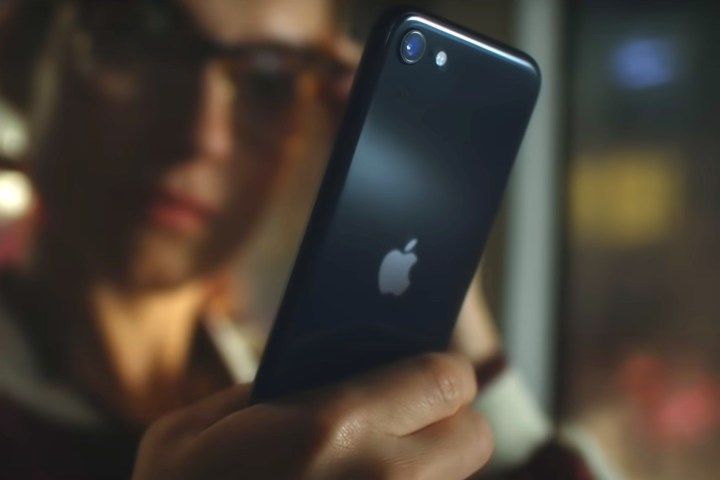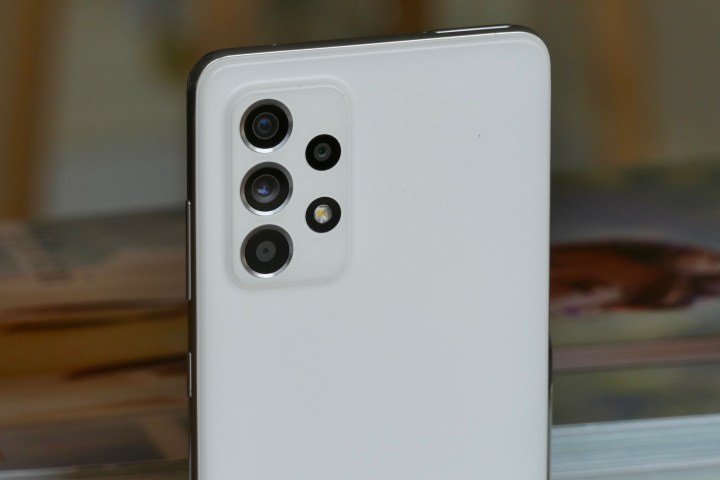The iPhone SE (2022) is the third entry in Apple’s affordable range of ‘Special Edition’ smartphones. Recycling the design of 2017’s iPhone 8, it receives the powerful Apple A15 Bionic processor of the iPhone 13, while also introducing 5G connectivity, an enhanced camera, a bigger battery than previous iPhone SEs, and a very competitive $429 price.
But in a market saturated with affordable Android devices, it certainly isn’t without its rivals. Perhaps the most notable of these is the Samsung Galaxy A52 5G. Another sub-$500 phone, it boasts a delicious 6.5-inch Super AMOLED display, a dependable 4,500mAh battery, a versatile camera, and the now-mandatory 5G support. It also offers very high value for the money, but as a one-year-old phone, is it better than the iPhone SE (2022)?
We answer this question in this iPhone SE (2022) vs. Samsung Galaxy A52 5G comparison test. We run through the specs, displays, designs, performance, batteries, cameras, and software of each phone, helping you to decide which is the high-powered budget phone for you.
Specs
| iPhone SE (2022) | Samsung Galaxy A52 5G | |
| Size | 138.4 x 67.3 x 7.3 mm (5.45 x 2.65 x 0.29 inches) | 159.9 x 75.1 x 8.4mm (6.30 x 2.96 x 0.33 inches) |
| Weight | 144 grams (5.08 ounces) | 189 grams (6.67 ounces) |
| Screen size | 4.7-inch Liquid Retina | 6.5-inch Super AMOLED |
| Screen resolution | 1334 x 750 pixels (326 pixels per inch) | 2400 x 1080 pixels (407 pixels per inch) |
| Operating system | iOS 15 | Android 11, OneUI 3 |
| Storage | 64GB, 128GB, 256GB | 128GB, 256GB |
| MicroSD card slot | No | Yes |
| Tap-to-pay services | Apple Pay | Google Pay, Samsung Pay |
| Processor | Apple A15 Bionic | Snapdragon 750G |
| RAM | 4GB | 6GB, 8GB |
| Camera | 12-megapixel wide rear, 7MP front | 64MP wide, 12MP ultrawide, 5MP depth, and 5MP macro rear, 32MP single |
| Video |
4K at 60 frames per second, 1080p at 120 fps |
4K at 30 frames per second, 1080p at 60 fps |
| Bluetooth version | 5.0 | 5.0 |
| Ports | Lightning | USB-C, headphone jack |
| Fingerprint sensor | Yes, front-mounted (Home button) | Yes, in-display |
| Water resistance | IP67 | IP67 |
| Battery | TBC | 4,500mAh
Fast charging (25W) |
| App marketplace | Apple App Store | Google Play Store |
| Network support | Most major U.S. carriers | Most major U.S. carriers |
| Colors | Black, White, Red | Awesome Black, Awesome White, Awesome Violet, Awesome Blue |
| Prices | $429 | $499 |
| Review score | News | 4.5 stars out of 5 |
Design, display, and durability

Let’s not beat around the bush: The iPhone SE (2022) is hardly the most attractive phone you’ll see released this year. It regurgitates the design of the iPhone 8, meaning you have a smallish phone with big forehead and chin bezels, as well as a Home button. If you like retro designs you might find it charming, but compared to the swish edge-to-edge display of the Samsung Galaxy A52 5G, it looks pretty uninspiring.
Samsung’s device also has the edge in the display department. Carrying a 6.5-inch Super AMOLED screen with a resolution of 2400 x 1080 pixels, it packs 407 pixels per inch. By contrast, the iPhone SE has a 4.7-inch Retina LCD screen, with a 1334 x 750-pixel resolution. This works out at around 326 pixels per inch, and when you factor in the marked reduction in size, the SE’s screen just isn’t anywhere near as impressive as the A52’s. Particularly when the latter supports a 120Hz refresh rate, which provides seamless scrolling.
One area of parity, however, is that both phones have been given an IP67 rating. This means both phones can tolerate being submerged in up to a meter of water for up to 30 minutes. Of course, this isn’t enough for the iPhone SE to make up for its less appealing design and less impressive display, so this round is an easy win for the A52.
Winner: Samsung Galaxy A52 5G
Performance, battery life, and charging

The Samsung Galaxy A52 5G is powered by the Qualcomm Snapdragon 750G, while it also uses 6GB of RAM as standard. This makes it a very capable smartphone, and it runs pretty much all the latest games and apps without fuss. That said, as good as it is, the unassuming iPhone SE (2022) comes with the very powerful Apple A15 Bionic, as well as 4GB of RAM. The use of the A15 Bionic — which is constructed using 5nm transistors — makes Apple’s phone astonishingly quick for such a small device, and as solid as the A52 is, the SE has a clear advantage.
Unfortunately, the SE commits the increasingly unforgivable crime of coming with 64GB of internal memory as standard (although for $479 you can have it with 128GB). This is a fairly paltry amount of storage in 2022, what with our growing need to take 20 different photos of the same scene to find the perfect image. As for the A52, it offers a more generous 128GB of memory as standard, giving you more or less twice the storage fun. It also has a slot for a microSD card, so you can really ramp up its memory.
At this stage, it’s hard to say which device has the more enduring battery, since we haven’t had the chance to fully review the iPhone SE yet. The Galaxy A52 has a 4,500mAh battery that can last for two days if you’re a moderate user, making it pretty good by contemporary standards. With the iPhone SE (2022), it does come with a bigger battery than its predecessor, but it’s still not known how much bigger. As such, we can’t say whether it could outlast the A52, and given that the iPhone SE (2020) had a fairly average battery, it’s not a given it will.
Winner: Tie
Cameras

The Samsung Galaxy A52 5G comes with a 64-megapixel wide lens, a 12MP ultrawide lens, a 5MP depth lens, and a 5MP macro lens at the rear. The iPhone SE (2022), on the other hand, comes with a single 12MP wide lens.
You’d therefore be forgiven for thinking that the A52 offers a much better camera, but this isn’t the case. Yes, the iPhone SE has only one lens, but Apple’s software squeezes every last ounce of quality out of it. As with the second-generation SE, it takes highly natural and well-balanced photos in most conditions. It also benefits from the addition of Apple’s Deep Fusion technology, Smart HDR 4, as well as an improved Portrait mode that uses the same Portrait Lighting effects seen on the iPhone 13.
In other words, its main camera lens is up there with the best in the business. The same cannot be said for the A52, which despite having a main lens with 64MP still suffers the same inconsistency and over-saturation issues as other Samsung phones that had come before it. So even with an additional ultrawide and macro lens, you probably won’t take as much pleasure from the A52’s camera as from the SE’s.
Winner: iPhone SE (2022)
Software and updates

The Samsung Galaxy A52 5G has now been updated to Android 12 with OneUI 4 running over the top. OneUI 4 is a noticeably fast Android skin, with plenty of customization options for making it suit your particular style. It’s neither better nor worse than the iPhone SE’s iOS 15, though Apple’s operating system historically favors simplicity and security over customization and complexity.
While it’s largely a matter of taste as to which OS you might prefer, there’s little doubt that the iPhone will receive more updates over its lifetime. Samsung has committed to three core Android updates for the A52, whereas you’ll likely get five or six with the SE. This means Apple’s phone takes the win.
Winner: iPhone SE (2022)
Special features

Both phones support 5G, which may not be remarkable nowadays, but is still commendable for such inexpensive phones. That said, both devices support only the longer-range sub-6Hz range of 5G frequencies and not the faster mmWave bands. Nonetheless, sub-6Hz 5G still represents a big step up in terms of speed over 4G, so most people won’t mind.
Both phones also come with fingerprint sensors. The iPhone SE has Touch ID through its Home button, and the A52 has an in-screen sensor. Unfortunately, the Galaxy A52’s scanner has some well-documented issues, and our review found it often refuses to recognize any input. This doesn’t apply to the iPhone SE’s scanner, as anachronistic as we find a Home button in 2022.
Other than these two features, neither phone really has any quirks or novelties to write home about. They’re just very affordable phones that, on the whole, happen to be very good.
Winner: Tie
Price and availability
The Samsung Galaxy A52 5G starts at $499 and can be bought directly from Samsung’s website. It’s supported by all major carriers in the U.S. and can be purchased from nearly every major online retailer.
The iPhone SE (2022) begins at $429 and rises to $579 for the version with 256GB of internal memory. It can be pre-ordered from Apple, and will be supported by all major networks.
Overall winner: iPhone SE (2022)
It isn’t a dominant victory, but the iPhone SE (2022) is a better phone overall than the Samsung Galaxy A52 5G. It certainly doesn’t look as good, and it’s screen isn’t as enticing, but it beats Samsung’s device in several key areas. It provides faster performance, has a noticeably superior main camera, and will be supported with updates for longer. It also supports 5G, which for a phone priced at $429, is pretty good going. Then again, the A52 remains a great low-cost phone, so if you’re an Android or Samsung fan, it certainly won’t let you down.
Editors' Recommendations
- iPhone SE 4: news, rumored price, release date, and more
- How to try Samsung’s Galaxy AI on any iPhone or Android phone
- The best iPhone 14 cases in 2024: our 19 favorite ones
- How to find downloaded files on an iPhone or Android phone
- iPhone Flip: what we know about Apple’s first foldable phone




